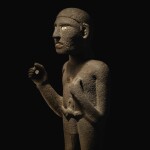Sculpture: Africa, Pacific, Americas
Sculpture: Africa, Pacific, Americas

Property from a Private Collection
Aztec Stone Figure of a Macehual, Postclassic, circa AD 1300 - 1521
Lot Closed
December 4, 05:11 PM GMT
Estimate
40,000 - 60,000 USD
Lot Details
Description
Property from a Private Collection
Aztec Stone Figure of a Macehual
Postclassic, circa AD 1300 - 1521
Height: 20 3/4 in (52.7 cm)
Fine Arts of Ancient Lands, New York
Shango Galleries, Dallas
Wally and Brenda Zollman, Indianapolis, acquired from the above on January 11, 1987
Sotheby's, New York, May 17, 1994, lot 197, consigned by the above
Private Collection, acquired at the above auction
Shango Galleries, Dallas
Wally and Brenda Zollman, Indianapolis, acquired from the above on January 11, 1987
Sotheby's, New York, May 17, 1994, lot 197, consigned by the above
Private Collection, acquired at the above auction
Lee A. Parsons, John B. Carlson, and Peter David Joralemon, The Face of Ancient America: The Wally and Brenda Zollman Collection of Precolumbian Art, Indianapolis, 1988, p. 197, cat. no. 135
Indianapolis Museum of Art, The Face of Ancient America: The Wally and Brenda Zollman Collection of Precolumbian Art, December 3, 1988 - February 26, 1989; additional venue: The Indiana University Art Museum, Bloomington, June 13 - September 10, 1989
This figure of a robust and resolute young man belongs to a class of Aztec sculptures that are thought to depict the young macehual, or common man. For the Aztecs, early manhood was the “most precious time in the life of men when they fulfilled their destiny as fathers, warriors and public servants” (Eduardo Matos Moctezuma and Felipe Solís Olguín, eds., Aztecs, London, 2002, p. 410, text to cat. no. 36). Not intended as individual portraits, sculptures such as this instead depict the Aztec aesthetic and ethical ideal of the macehual, a calm, humble, dignified, and strong figure who sustained “the Aztec world with his might.” (ibid., p. 409, text to cat. no. 34).
Here the steadfast, sturdy macehual stands alert, naked save for his sandals and máxtlatl, or loincloth, which is tied in a large vertical knot that emphasizes his masculinity. His left hand is raised and held to his chest, whilst he holds his right hand out, thumb and forefinger together. In this hand he probably once held a standard of some perishable material; figures of this type and posture are known to have been “placed on or near the temples […where they held] flags or banners during festivals” (Esther Pasztory, Aztec Art, New York, 1983, p. 228).
A small hollow in the center of chest was probably once inlaid. Discussing a related figure in the collection of the Museo Nacional de Antropología, Felipe Solís Olguín and Roberto Velasco Alonso note that the hollow in its chest would “originally have been filled with greenstone, a ‘heart’ that gave the figure life.” (Eduardo Matos Moctezuma and Felipe Solís Olguín, eds., Aztecs, London, 2002, p. 410, text to cat. no. 36). Whilst the “heart” is absent, this figure is brought to life by the intent gaze of the inlaid shell eyes and teeth, which gleam white against the somber grey stone.
Here the steadfast, sturdy macehual stands alert, naked save for his sandals and máxtlatl, or loincloth, which is tied in a large vertical knot that emphasizes his masculinity. His left hand is raised and held to his chest, whilst he holds his right hand out, thumb and forefinger together. In this hand he probably once held a standard of some perishable material; figures of this type and posture are known to have been “placed on or near the temples […where they held] flags or banners during festivals” (Esther Pasztory, Aztec Art, New York, 1983, p. 228).
A small hollow in the center of chest was probably once inlaid. Discussing a related figure in the collection of the Museo Nacional de Antropología, Felipe Solís Olguín and Roberto Velasco Alonso note that the hollow in its chest would “originally have been filled with greenstone, a ‘heart’ that gave the figure life.” (Eduardo Matos Moctezuma and Felipe Solís Olguín, eds., Aztecs, London, 2002, p. 410, text to cat. no. 36). Whilst the “heart” is absent, this figure is brought to life by the intent gaze of the inlaid shell eyes and teeth, which gleam white against the somber grey stone.
